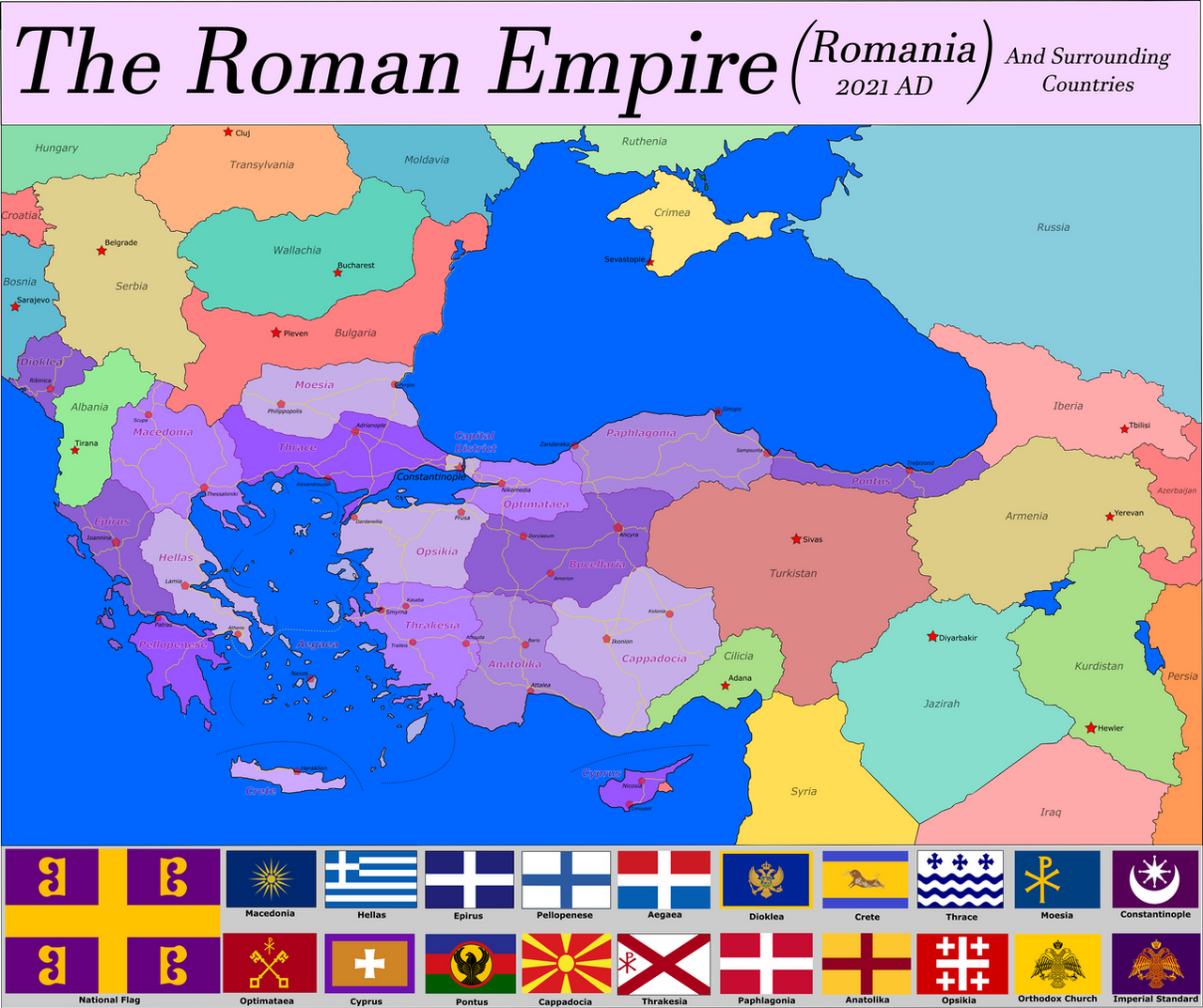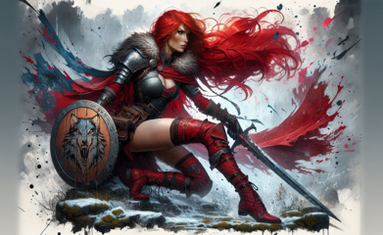HOME | DD
 JakeBakeSnakeCake — Roman Empire, 2021
JakeBakeSnakeCake — Roman Empire, 2021

#roman #romanempire #byzantine_empire #alternatehistory #byzantine #byzantium #byzantineempire #alternate_history #alternatehistoryflag #alternatehistorymap #roman_empire #alternate_history_map
Published: 2021-06-28 05:20:49 +0000 UTC; Views: 17543; Favourites: 98; Downloads: 18
Redirect to original
Description
English language map of the Roman Empire in the year 2021.
Known informally as Romania in modern times, the Greek-speaking nation is nonetheless the uninterrupted continuation of the eastern half of Augusts' Roman Empire even if 2000 years of social evolution have brought it fully into the 21st century. Romania's great city of Constantinople has survived as it's capital since 330 AD, with an Emperor serving in a series of roles which have settled into one of appointing the Orthodox Church's religious leadership and as lead jurist of the federal High Court.
With the advent of easily available dye, the Imperial Purple has become the national color of the Romans- featuring on the flag, passports, and it's coloring on most maps. This map is no different, with Romania colored ion purple and it's surrounding countries in other colors. The shades of purple represent the Themes, province-level divisions which evolved from the medieval era military districts of the same name. The themes are labeled in purple, with their respective capitals marked by pentagons and other major cities marked with circles. In most cases, the Theme names have been taken from actual Byzantine themes, with historical names used for others. Some, namely Cappadocia and Moesia, were displaced from their original locations in the last 1000 years of reorganizations. The Imperial Highway system, an autobahn-style freeway system, is shown in yellow.
The Empire is of course unrecognizable in many ways from the Classical Era's Roman Empire read about in history books, but surprises visitors in some ways just the same. The Imperial pomp and purple, lively passion for urban horse and chariot racing, and the neoclassical public buildings of the 16th century's passionate architectural revivalism remind any visitor that the Roman Empire truly never fell.
The primary divergence for this alternate timeline is the migration of the Turks. Following a significantly better Roman showing at the Battle of Manzikert, the Turkish victory was a pyrrhic one and many fo the settlers who moved into Anatolia IRL would move into Mesopotamia and modern Azerbaijan. These steppe horse archers would topple the remaining Abbasid rump state and form a Turkish Empire from Anatolia to the Persian Gulf. The Mongol invasions would push them back into Anatolia, where the westerners under Imperial rule continued to assimilate but the easterners remained fiercely independent. Once the Ilkhanate collapsed under Persian rebellions, the Turkish Empire was reestablished across Mesopotamia. During the early 20th century, this state would pull all surrounding nations into war as it split under internal pressure into the Majority-Turkish Republics of Turkistan and Azerbaijan, majority Arab Iraq, Kurdistan, Armenia, and the sultanate of Jazira- an ethnically diverse state where no one ethnoreligious group held a large enough plurality to secede and still ruled by the Turkish Sultan.
The Roman’s history has been a series of highs and lows, from the nadir of the 1100’s when Romania reached it’s smallest size as Turkish and Bulgar incursions hollowed out the core territories, to a new height in the 1600’s as the Balkans were under Roman domination, literacy, arts, science, and industry flourished, and Western Anatolia was fully Romanized once again. Indeed, the Turks of western Anatolia would go on to become some of the most valued citizens of the Empire, and their cultural influences can still be felt today. Emperor Osman’s conversion to Orthodoxy in imperial service, and unlikely rise to the very top, helped catapult the armies back to greatness as the combination of steppe-style horse archers softening targets before a Greek-style cataphract charge won the day on many battles.
The age of nationalism was not kind to the Roman Empire, which had retained multiethnic peripheral regions despite the increasingly homogeneously Greek core. Over the 1800’s, Bosnia would move from protectorate to independence (while retaining their ties vie the Orthodox Church), Albania, Serbia, Wallachia, and Bulgaria declare independence, and dominance over Crimea would be challenged in a series of wars until a neutral independent republic was formed. Without a Bosporus treaty, access to the Black Sea is less useful for any other nations as free access is never guaranteed.
In the modern era, the Roman Empire is tied strongly to both Europe and the Middle East economically as an industrialized and wealthy nation. It is at the center of an alliance and economic trade zone which extends Romania’s military and economic power over its traditional area of influence, and this alliance’s trade agreements with the European Union in the west have only increased the Romans’ economy and influence. Like many states, the people of Romania are increasingly secularized, with a divide between the secularized and liberal Aegean core and the religious Anatolian/Balkan interiors.
The Emperor no longer holds the high powers he once did, being appointed to lifetime term by the Senate and archbishops within the Empire, the Senate itself elected by the citizens of the Empire. Executive powers are instead invested in the popularly elected Consul, a title revived as neoclassical renaissance coincided with an era of popular demands for representation. The Emperor retains the right to appoint the Patriarch of Constantinople, recognized as leader of the Church in both Romania and the countries in its orbit. He also sits at the head jurist of the Imperial Court, which has evolved into a Supreme Court, the final court of appeals and arbiter between government entities. The emperor is joined by 6 others appointed to lifetime terms, two appointed by the emperor, two by the senate, and two by the Consul.
Feel free to ask about flags.
Related content
Comments: 7

👍: 0 ⏩: 0

👍: 0 ⏩: 0

👍: 0 ⏩: 1

👍: 0 ⏩: 1

👍: 0 ⏩: 0

👍: 0 ⏩: 1

👍: 4 ⏩: 0
























